Apple iPhone 5s vs Samsung Galaxy S4: Smartphone Face-Off
The iPhone 5s and Samsung Galaxy S4 fight for smartphone supremacy in a multi-round battle. See which flagship phone comes out on top.

During the launch event for the iPhone 5s, Apple CEO Tim Cook told the crowd, "We don't pack in feature after feature." That was obviously a dig at Samsung, whose Galaxy S4 crams the most features of any smartphone we've tested, including a TV remote and an array of gestures. Certainly, the iPhone 5s and Galaxy S4 take vastly different approaches, which makes it that much tougher to decide what to buy. That's where we come in.
The iPhone 5s is all about enhancing an already great phone, with improvements ranging from a faster A7 processor and a beefed-up camera to a new fingerprint sensor. On the other hand, the Galaxy S4 pushes the envelope with some impressive specs of its own, including a 5-inch 1080p display and a 13-MP camera. Here's how the two flagship smartphones stack up in multiple categories.
Editors' Note: We have updated an earlier preview face-off with more direct comparisons between the iPhone 5s and Galaxy S4, declaring an overall winner.
Design
Apple knows how to make more beautiful and solidly built smartphones than Samsung does, and that doesn't change with the iPhone 5s. The aluminum-and-glass design feels just as premium as before, but it's now available in three color options: space gray, gold and silver. Plus, the 5s is just as light (3.9 ounces) and thin (0.3 inches) as before while packing a lot more power. The gold version looks classy without being ostentatious. The chambered edges still look great and have a premium vibe.

The Galaxy S4, on the other hand, is an uninspired plastic slab. Yes, it's light considering it has a larger 5-inch display, but the S4 doesn't have a top-tier look or feel like the iPhone 5s. What we do like about the S4 is that the back is removable, allowing you to access the memory-card slot and replace the battery. Samsung mixes a physical home button with capacitive keys beneath the screen, which works but doesn't feel unified.
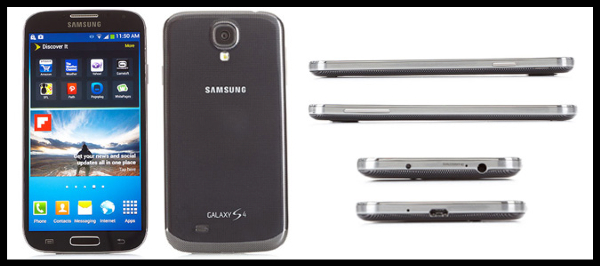
Winner: iPhone 5s. The iPhone 5 already had a better design, and now you get more color options with the 5s.
Display
There's something that feels dated about the iPhone 5s' smaller 4-inch screen. At 1136 x 640 pixels, Apple's device has a much lower resolution than the S4's 1920 x 1080p display. You really notice this resolution delta when surfing the Web, viewing photos and watching videos. For instance, when we paused on the same scene in the "Thor 2" trailer, we could make out a lot more detail in the superhero's outfit on the S4. And, thanks to the Galaxy S4's AMOLED technology, his red cape popped a lot more.
Get instant access to breaking news, the hottest reviews, great deals and helpful tips.

On the other hand, the 5s delivered warmer, more natural-looking colors. Natalie Portman's hands, as well as buildings in the background, looked more true to life.
The Galaxy S4's extra inch of display gives it another advantage over the iPhone 5s. Reading e-books, watching movies and playing games all feel more comfortable and immersive on the Samsung. Plus, typing is a more pleasurable experience because there's simply more real estate.
The 5s does has a brighter screen, which makes it easier to view content. The latest iPhone registered 500 lux on our light meter, compared to 480 lux for the Galaxy S4. More important, it's considerably easier to read content outdoors on the 5s' display than on the S4.
Winner: Samsung Galaxy S4. A bigger and sharper screen on the Samsung outweighs the iPhone 5s' brighter LCD and more accurate color reproduction.
Audio
As on its predecessor, the iPhone 5s' speaker is on the bottom of the device. We're not fans of this placement, because it's too easy to muffle the sound when you hold the phone in landscape mode. Interestingly, the iPhone 5s produces richer audio than its predecessor.
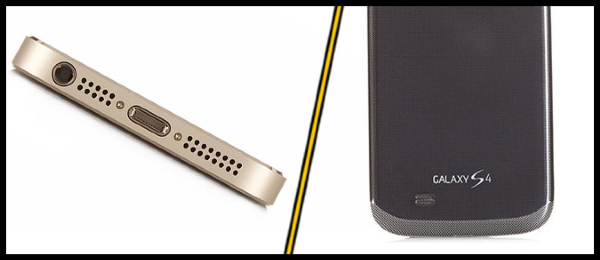
When we played Lady Gaga's "Applause" track on the 5s and S4, Apple's speaker sounded much crisper. The song on the S4 sounded tinnier and less distinct. We noticed the same sonic difference when playing movie trailers. However, the S4 registered as slightly louder on our decibel meter, hitting 81 dB, compared with the iPhone 5s' 70 dB.
Winner: iPhone 5s. The iPhone 5s just sounds better.
Interface and Software
The iPhone 5s gets a whole new look with iOS 7, which gives the device some much-needed enhancements. Our favorite new features include improved multitasking (just double tap the home button to see a new thumbnail view of recent apps) and Control Center for tweaking settings — such as Wi-Fi, Airplane Mode and screen brightness — on the fly. A new Notification Center gives you a Today view for info you need to know now, as well as separate tabs for All and Missed alerts.

While iOS 7 looks more polished, it's also less familiar than previous versions of Apple's iPhone software. In an effort to make the design flat and modern, some of the app icons look downright strange, such as those for Game Center and Safari. On the plus side, you won't find any carrier crapware or unwanted third-party apps cluttering your home screens, as you do on the Galaxy S4. Another perk is Spotlight Search; you can start searching for emails, apps, contacts and more just by swiping down on any home screen.
Although it's busier, the Galaxy S4's TouchWiz UI gives you notifications and quick settings in a single view. You can also customize the order of these settings. Unlike on iOS 7, when you long press on an icon in the Quick Settings menu, you go to that menu under Settings. So, for example, you could quickly select a different Wi-Fi network with a long tap. With iOS 7, you have to go into the Settings app first.

Where Samsung really pulls ahead is its lock-screen customizations and split-screen multitasking. We really appreciate that Samsung's TouchWiz lets you unlock to any app you want. With the 5s, you can just unlock to the camera. And with Samsung's Multi Window feature, you can run two apps on the screen at the same time.
Winner: Samsung Galaxy S4. The iPhone 5s catches up to the S4 in some ways with iOS 7, but Samsung's device offers more features and customization.
Keyboard
Other than having a thinner font, there's nothing new about the keyboard on iOS 7. That's not such a bad thing, given that it's still as fast and accurate as ever. Still, the Galaxy S4 keyboard has a lot more to offer. You get a dedicated number row, Swype support for trace typing and next-word prediction. We made more errors on the S4 keyboard when typing the same sentences, but overall, we appreciated its flexibility.

Plus, you can always swap out the standard layout on the S4 for Google's keyboard or a third-party alternative — something you can't do on the iPhone 5s. Last but not least, the S4 supports offline voice typing, while the iPhone funnels your words through a server, making you wait for transcriptions to show up on screen.
Winner: Samsung Galaxy S4. This round is closer than you might think because of the iPhone 5s' better accuracy, but the S4 gets the nod because of its better keyboard features and offline voice typing.
Specs and Performance
The iPhone 5s sports an all-new A7 chip and 64-bit architecture that promise double the performance and graphics power — and the iPhone 5 was already one of the fastest phones on the market. The Galaxy S4 is no slouch in the performance department, though, rocking a quad-core Qualcomm Snapdragon 600 CPU.
On Geekbench 3, which measures processor and memory performance, the 5s notched 2,556, which is nearly double the older iPhone 5's mark of 1,297. The Galaxy S4 scored a lower 1,880.

We also ran the 3DMark Ice Storm Unlimited test, which gauges graphics performance. The iPhone 5s scored a very high 13,795, while the Galaxy S4 notched 10,393.

The 5s continued its domination on the SunSpider JavaScript test, taking only 411.4 milliseconds. (Lower numbers are better.) The Galaxy S4 took more than twice as long, at 1089.5 milliseconds.

What about real-world performance? The iPhone 5s was quicker to launch its camera, taking 1.09 seconds, compared with 1.74 seconds on the Galaxy S4. Reopening the browser to the NYTimes home page after it was loaded took 0.79 seconds on the 5s, versus 1.09 seconds on the S4. The 5s' accelerometer was also slightly faster when we changed screen orientations within the browser.
The only area where the iPhone 5s and Galaxy S4 were neck and neck — and, in some of those cases, the Samsung was faster — was exiting to the home screen from an app. This didn't used to be the case, but for some reason, Apple chose to use a fancy animation in iOS 7, which introduced some lag.
Winner: iPhone 5s. Thanks to its new A7 processor, the iPhone 5s is faster than the Galaxy S4 in practically every way.
Special Features
The standout feature on the iPhone 5s is its fingerprint sensor. Touch ID lets you unlock your device or make iTunes purchases just by touching your finger on a sensor built into the phone's home button. This feature can be a huge time-saver, especially since many of us glance at our phones more than 100 times per day. We just wish there was more you could do with Touch ID; hopefully, Apple will open up the feature to developers soon.

The iPhone 5s also packs a M7 motion coprocessor, which is designed to be used with fitness apps. Nike is one of the first partners on board. The goal of the M7 coprocessor is to capture motion data while using less power. The iPhone 5s is smart enough to know if you're driving or walking, so it can transition to walking directions automatically after you park. However, at least until there are more apps that can take advantage of the chip, M7 is more about potential.
With iOS 7, Siri gets an upgrade with improved performance and better Twitter integration. You can also issue commands for the assistant to perform tasks, such as returning calls and changing settings like Bluetooth. Want to share files with other iDevices? AirDrop makes it easy, which works over Bluetooth and Wi-Fi. Unlike the S4, it's a cinch to share pictures and other files with multiple people at once.
The Galaxy S4 is all about special features. But which ones live up to the hype? Although the eye scrolling is hit or miss, we appreciate Air Gestures for answering the phone or skipping music tracks with a wave of your hand. Air View comes in handy for previewing content (like emails) just by hovering your finger above the screen — but it can also be too sensitive.

The S4 can also double as a remote control, letting you see what's on TV and change the channel from across the room. Other features include S Health for keeping track of your fitness and S Translate for translating multiple languages (speech and text).
Winner: Samsung Galaxy S4. Even when you throw out gimmicky features, the S4 still has more to offer.
Camera
Apple didn't bump up the resolution on its 8-MP iSight camera, but the iPhone 5s still represents a significant imaging upgrade. The sensor is 15 percent larger than the one on its predecessor, and there are bigger pixels and a f/2.2 aperture, so users should expect brighter and crisper images. Other highlights include a continuous-burst mode (the iPhone 5s presents what it thinks is the best photo) and a dual True Tone flash for more natural-looking photos. Samsung's Galaxy S4 has a higher megapixel count of 13 MP, along with a host of unique features. But let's start with photo quality.
We took several images with both smartphones indoors and outside, starting with a shot of flowers and dolls outside. The S4's image had more saturated color, but at the expense of some detail as we zoomed in. You'll see that the straw looked more natural in the iPhone 5s' shot.

Indoors, a photo we took of a hanging painting looked less realistic on the iPhone 5s — the gold frame was too gold.
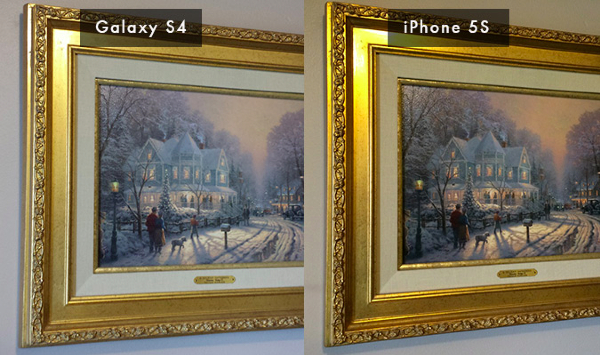
The 5s redeemed itself when we took a shot of Halloween decorations using the flash in almost complete darkness. While a tad darker, the 5s' image had better color accuracy and produced more details and shadows; the S4's was more blown out.

The iPhone 5s captured a much more pleasing photo of a gray pickup truck. The S4's shot had an ugly haze, while the 5s' image was more evenly exposed, delivering better color accuracy both in the foreground and the background.

A close-up shot of a leaf looked brighter (both the leaf and the pavement) on the S4, but we could make out more of the nuances in color in the iPhone 5s' image.

We took a couple of other close-up shots with both phones. The S4 delivered a brighter and more detailed image of an orange flower. But the iPhone 5s delivered richer and more natural-looking colors on that image, and we found the same to be true when we took a photo of a building's facade.
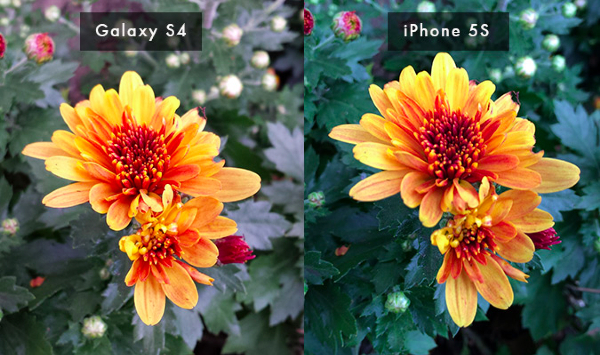
Last but not least, we shot a landscape photo with the iPhone 5s and Galaxy S4 on a sunny day. We preferred the 5s' shot because the blue sky looked more blue, and the sun looked better on the buildings. The S4's image was a little cold by comparison.
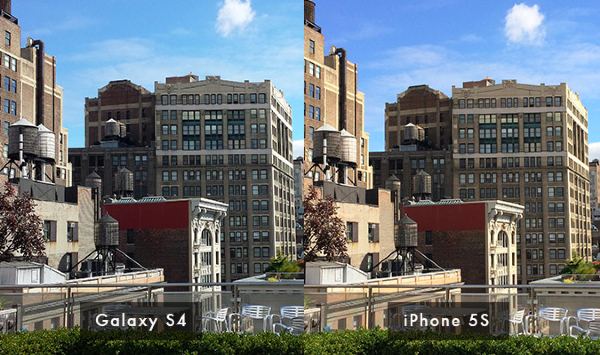
On the video front, our 1080p footage on the iPhone 5s of passing NYC traffic looked just as sharp as the S4's. However, the iPhone 5's image stabilization better steadied the clip as we walked, and Apple's device did a better job of capturing the blue in the sky as we panned up.
Winner: iPhone 5s. The Galaxy S4 delivers more detail in nearly all cases, but overall, we give the edge to the iPhone 5 because of its better color accuracy, contrast and flash photography.
Camera Features
As smartphone cameras get more sophisticated, we believe it's important to separate image quality from camera features. The iPhone 5s gets a few new tricks, including burst mode and optical image stabilization, as well as slow-motion video.
You'll also find all the features that come along with iOS 7, such as creative filters for your shots.
However, the Galaxy S4 has a lot more features, including a Dual Camera mode that lets you take photos using the front and back cameras at the same time. We especially like the Drama Shot mode, for stitching sequence shots together, and the Animated Photo Mode. The iPhone 5s doesn't capture GIFs. Although it doesn't always work, we appreciate the Galaxy S4's Eraser Mode, which helps you zap would-be photobombers.

iOS 7's new intuitive Photos app organizes your pics by Years, Collections and Moments. Samsung goes even further with its Gallery App, a bundled app that offers more views (Albums, Time, Locations, People and even Spiral). However, it's not as easy to navigate.

Samsung also offers a separate Story Album app, which lets you create photo albums (with your choice of five themes) and then print them through online services. While we wish it were integrated into the Gallery app, we still found it easy to use.

Winner: Samsung Galaxy S4. With its myriad fun and powerful features, you'll have a blast taking pictures with the S4.
Battery Life
Apple doesn't list the capacity of its battery on the iPhone 5s, but a teardown revealed that it packs a 1,560 mAh battery, up from the 1,440 mAh battery on the iPhone 5. The Samsung Galaxy S4 has a 2,600 mAh battery.
The Sprint version of the S4 lasted 5 hours and 49 minutes on the LAPTOP Battery Test, which involves continuous Web surfing over 4G LTE on 40 percent brightness. That's below the 6:06 smartphone category average, but the S4 lasted a better 6:05 with its power-saving mode turned on.
The AT&T version of the S4 lasted 5:13 in regular mode and 5:54 in power-saving mode, while the Verizon model lasted 5:25 in standard mode. Fortunately, the S4's battery is removable, so you can swap in a new pack or buy an extra-capacity battery.

The iPhone 5s on AT&T lasted 5 hours and 46 minutes on the same tests, which is about a half hour longer than the AT&T S4 in regular mode but a few minutes off the Samsung’s power-saving mode runtime.
Winner: Samsung Galaxy S4. Although it's pretty close, the S4 lasts a few minutes longer in power saving mode, and you can swap out its battery.
Apps and Content
Samsung is competing directly with iTunes by offering its own Samsung Hub. From one place, you can buy music, video, books and games with your Samsung account. During our testing, both the Samsung Hub and iTunes stores offered similar selections. For example, we found "World War Z," "Iron Man 3" for sale and rent, and "The Hangover Part III" for purchase in both stores. Both stores also stock popular TV shows, including "The Big Bang Theory" and "Glee."
However, only iTunes stocked other hits such as "Grey's Anatomy" and "Marvel's Agents of S.H.I.E.L.D." during our testing. Apple also offers a more robust book selection. The Samsung Hub didn't stock several New York Times best sellers we searched for, including "W is for Wasted" and Billy Crystal's "Still Follin' 'Em."
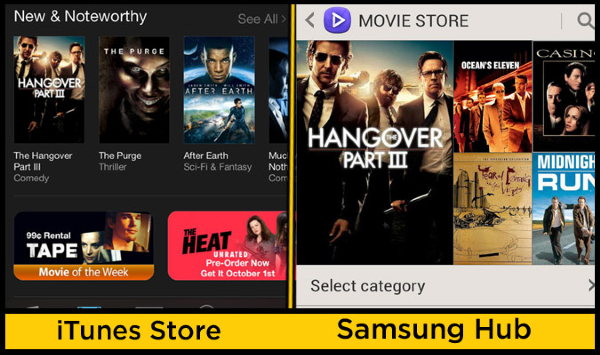
On the app front, the Google Play store stocks more than 700,000 apps (some for tablets, but most for phones), compared with more than 525,000 apps for the iPhone. However, numbers aren't everything. Because of developer support, the iPhone tends to get some of the most compelling apps first, such as "Infinity Blade 3," Snapguide and Clear. All of these are exclusive to iOS, at least for now.

Android does have some advantages. Some apps — such as the multitude of Launcher utilities — demonstrate that Google's platform lets you go further in terms of customizing your device.
Winner: iPhone 5s. The combination of iTunes' bigger content library and the fact that many of the hottest apps hit iOS first make the iPhone 5 the winner of this round.
Overall Winner
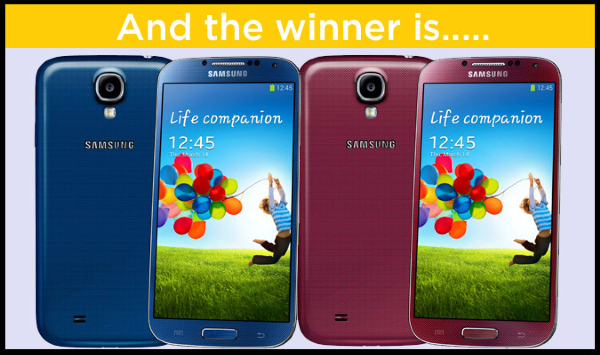
The choice between the older iPhone 5 and Galaxy S4 was difficult, and it doesn't get any easier now that the iPhone 5s is here. Looking at our scorecard, the Galaxy S4 wins six rounds to the iPhone 5s' five, giving Samsung a very narrow victory. But your decision should really be based on what strengths resonate with you the most.
| iPhone 5S | Galaxy S4 | |
| Design | X | |
| Display | X | |
| Audio | X | |
| Interface and Software | X | |
| Keyboard | X | |
| Specs and Performance | X | |
| Special Features | X | |
| Camera | X | |
| Camera Features | X | |
| Battery Life | X | |
| Apps and Content | X | |
| TOTAL | 5 | 6 |
The iPhone 5s offers faster performance (thanks to its A7 chip), a more premium design (now in more colors), a superior content and app selection, and better audio quality. And even though the Galaxy S4's camera has a higher megapixel count, overall, we preferred the images taken by the iPhone 5s' improved iSight camera. Plus, once developers can tap into both the Touch ID sensor and M7 coprocessor, the 5s will improve with age.
On the other hand, the Galaxy S4 boasts a bigger and sharper 5-inch display, which will sway many shoppers. And even though iOS 7 is improved, Samsung's TouchWiz UI lets you better tailor the interface to your own needs. The S4 also has more special features, such as its TV remote control, gesture support and multiple camera modes. Although the iPhone 5s and Galaxy S4 offer comparable battery life, only the S4 lets you swap out the battery for another pack and expand its memory.
Overall, the iPhone 5s is best for those who demand faster performance and a superior camera in a compact design. But if bigger is better for you — both in terms of screen size and features — the S4 is the smartphone to get.
Follow Mark Spoonauer at @mspoonauer. Follow Tom's Guide at @tomsguide, on Facebook and on Google+.
Mark Spoonauer is the global editor in chief of Tom's Guide and has covered technology for over 20 years. In addition to overseeing the direction of Tom's Guide, Mark specializes in covering all things mobile, having reviewed dozens of smartphones and other gadgets. He has spoken at key industry events and appears regularly on TV to discuss the latest trends, including Cheddar, Fox Business and other outlets. Mark was previously editor in chief of Laptop Mag, and his work has appeared in Wired, Popular Science and Inc. Follow him on Twitter at @mspoonauer.

